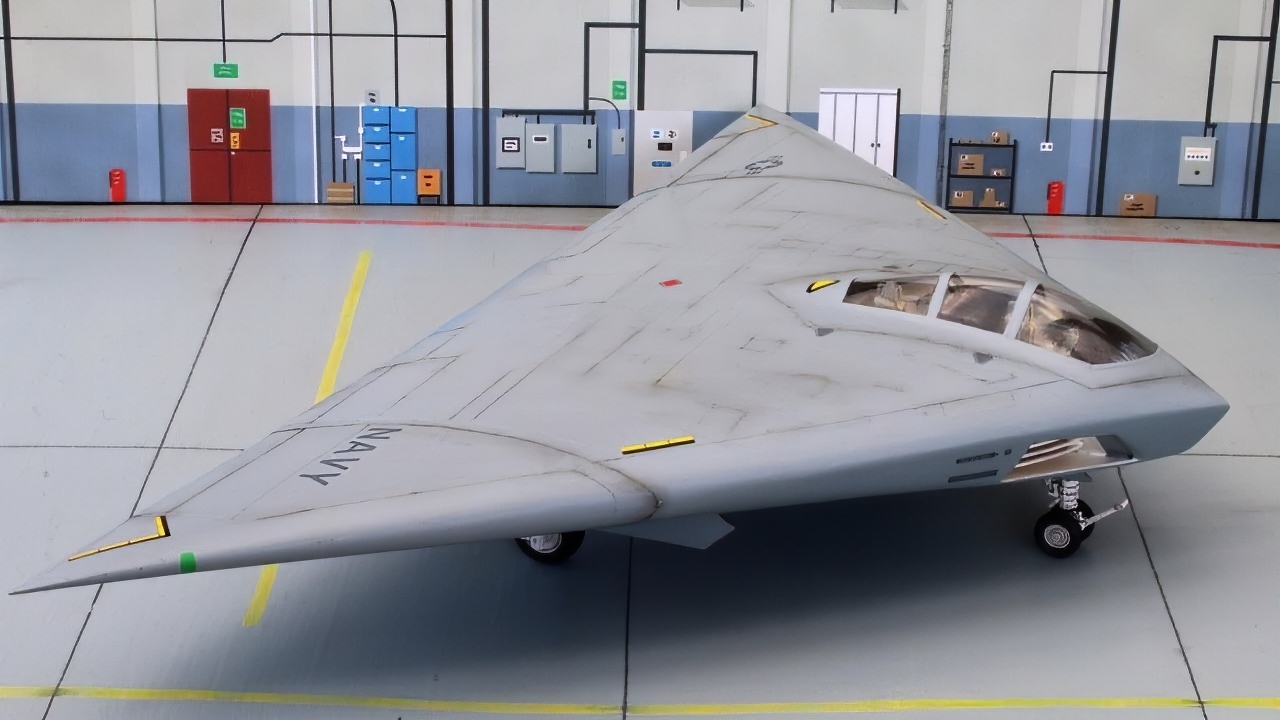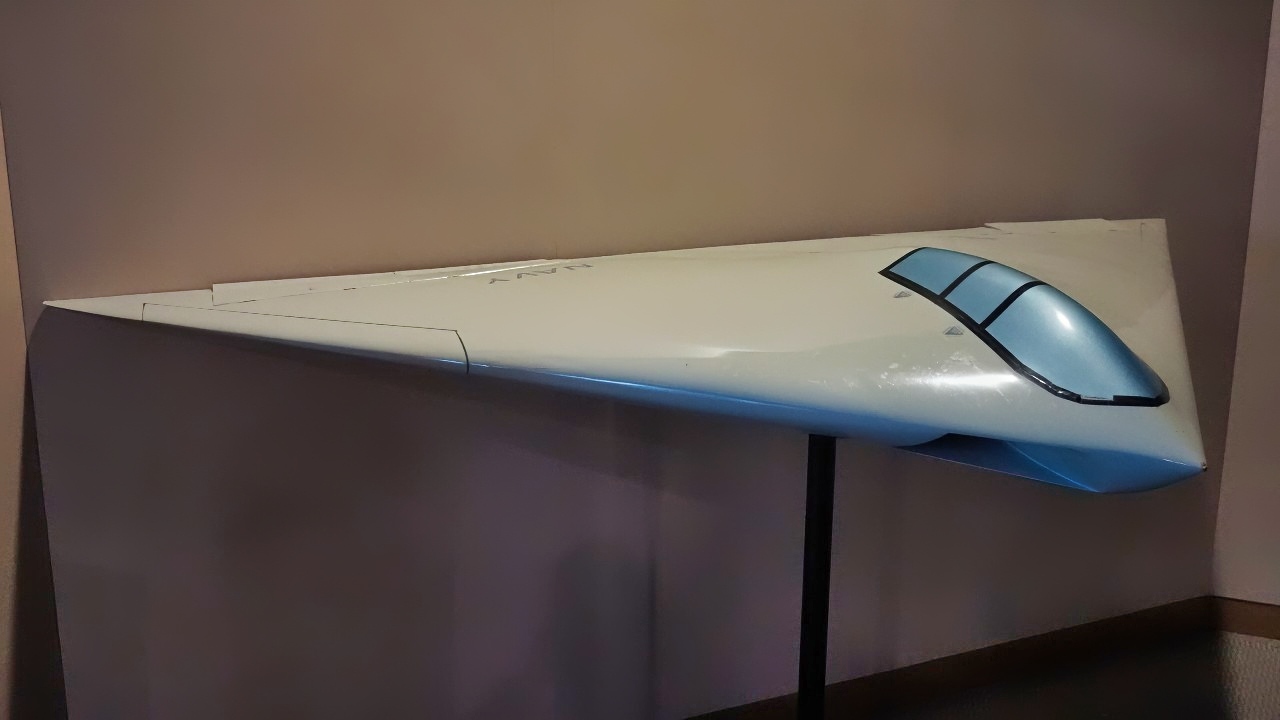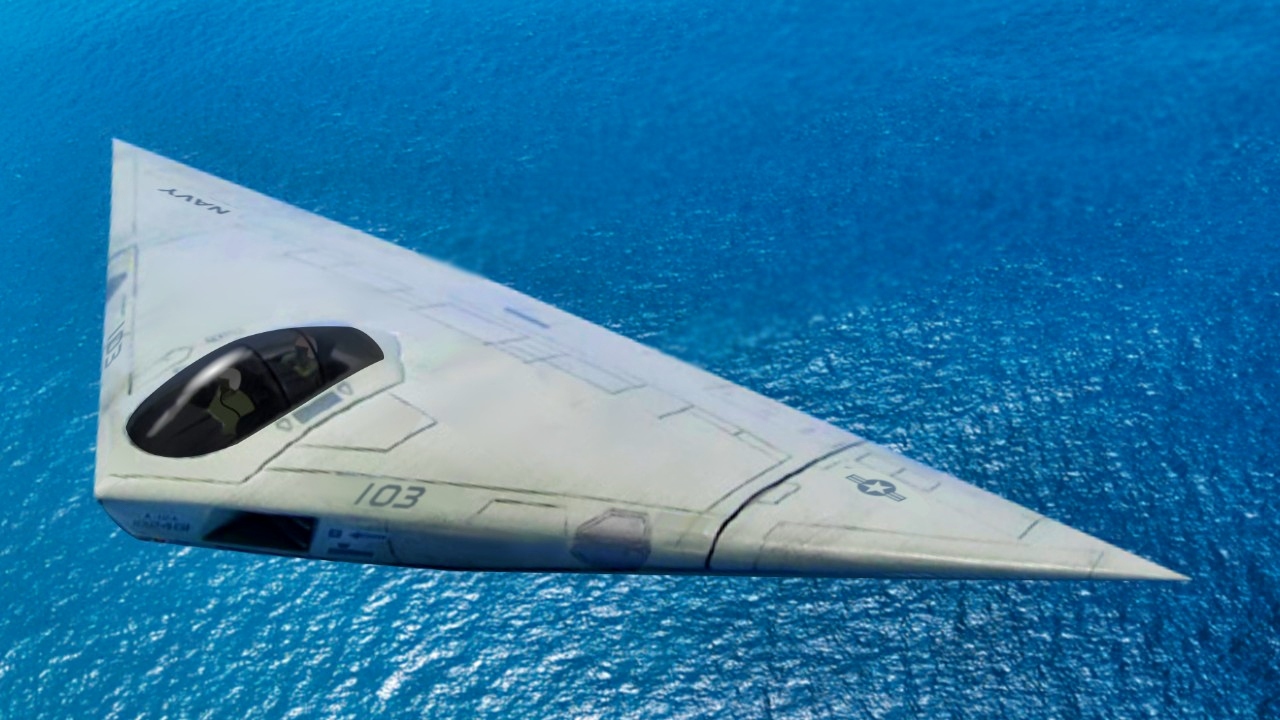A-12 Avenger II: The Stealth Attack Jet That Never Flew—But Still Shapes Naval Airpower
Key Points and Summary – The A-12 Avenger II was the U.S. Navy’s bid for a stealthy, carrier-based replacement for the A-6 Intruder: tailless delta shaping, internal weapons, and all-weather precision from the deck.

A-12 Avenger II Flying Dorito Mock Up Image. Image Credit: Creative Commons.

A-12 Avenger II Model. Image Credit: Creative Commons.
-It promised low signature, range, and bring-back in a single package, but weight growth, composite manufacturing challenges, schedule slips, and rising cost ended the program in 1991 before first flight.
-Its cancellation reshaped naval aviation, pushing the fleet toward evolutionary strike fighters and standoff weapons.
-Even so, the A-12’s core ideas—internal carriage, signature control, maintainable stealth, and carrier margins—live on, and the unfinished airframe remains a mile marker for future sea-based stealth.
Origin Story: Why The Navy Wanted A New “Intruder”
By the late Cold War, the U.S. Navy’s A-6 Intruder—famous for hitting targets at night and in bad weather—was running out of growth room.
The fleet needed a carrier-based attack aircraft with much lower signature, longer range, internal weapons, and the ability to survive dense, modern air defenses.
The Advanced Tactical Aircraft (ATA) program answered with the A-12 Avenger II, a stealthy, carrier-suitable strike jet proposed by a McDonnell Douglas/General Dynamics team.
The vision was simple and radical: combine low observability with the bring-back, deck handling, and reliability that naval aviation demands, so carriers could open the door on “night one” without asking for land bases or permission.
The Shape Wasn’t A Joke—It Was A Radar Strategy
The “flying Dorito” nickname stuck, but the triangular silhouette was about signature control.
The A-12’s tailless delta/flying-wing planform, aligned leading and trailing edges, buried inlets with S-ducts, and fully internal weapons bays were chosen to minimize radar returns from every aspect relevant to an ingress/egress strike profile.
The expansive composite skins weren’t styling; they were integral structure intended to support loads while maintaining continuous, seam-light surfaces that play nicer with stealth coatings.
In short, the jet looked unusual because it was purpose-built to be hard to see and hard to target—while still trapping on the carrier in real weather.
What The Jet Was Supposed To Do
The A-12 wasn’t designed to wow an airshow crowd. Its job was to slip into defended airspace at night, map and designate precisely, deliver internal precision munitions, and leave before defenders built a quality track.
That implied a fused cockpit, a terrain-following/terrain-avoidance autopilot, a multi-mode radar with synthetic aperture and moving target cueing, integrated electronic warfare, and tight emissions discipline.
Range mattered: the Navy wanted to launch from outside the densest missile belts and still hit meaningful targets. In the carrier air wing, the A-12 would have been the quiet door-opener, letting other strike assets and follow-on packages flow into the window it created.
Why Building It Was Harder Than Drawing It
Where the concept met the factory, the materials and manufacturing load proved punishing. The program depended on large composite structures at an industrial scale naval aviation hadn’t fielded.
Composites promised weight savings and stealthy continuity, but demanded high-yield processes, exacting cure/layup discipline, and reliable inspection methods that were still maturing. As structures emerged, weight growth began to erode bring-back and range margins; schedule slips followed because re-working big composite pieces is slow and expensive.
Carrier suitability is ruthless about margins. Add weight and drag, and approach speeds creep up; the hook-to-ramp window narrows; deck handling and fatigue models get touchy. Engineers chased ounces, refined interfaces, and looked for every gram they could claw back—but the calendar kept moving and bills kept climbing.
The Cancellation: A Program Runs Out Of Runway
By early 1991—just as the Cold War ended and budgets started to tighten—the A-12 crossed Washington’s tolerance lines on schedule, weight, and cost. The program was terminated for default, an unusually hard stop that ended the Navy’s first carrier stealth attack jet before first flight and lit off years of litigation over responsibility and remedies.
Cancellation didn’t just remove an airplane from a spreadsheet; it reshaped naval aviation: A-6 retirement timelines shifted; the Navy explored A-X and later A/F-X; then the service pivoted to an evolutionary path with the F/A-18E/F Super Hornet, while stealth crept into the force through other channels.
A-12 Avenger II: What The Fleet Lost When The Stealth Warplane Died
One view suggests the A-12 saved the Navy from a money pit. Another, equally valid, says the cancellation opened a real operational gap.
Instead of a stealthy, long-range, internally armed night attacker, carrier wings relied on non-stealth strike fighters with external tanks and weapons, using tactics, jamming, and standoff munitions to survive. Naval aviation adapted—it always does—but the geometry changed.
A deck-based stealth striker would have shortened tanker strings, expanded target sets, and given the air wing more first-night options than it had for years afterward.
We also lost an opportunity to industrialize large-airframe composites for saltwater life a decade earlier. The A-12’s struggles didn’t mean composites were wrong; they meant the learning curve hadn’t been paid yet. In aerospace, hard-won process knowledge rarely disappears; it migrates to the next program that’s ready to use it.
“Ugly” Or Purpose-Built? Look Again
Picture this: stand beside the surviving A-12 airframe article in your mind, and you notice what memes miss. The platform is clean; fasteners and seams are minimized; inlets are buried; bays are internal; panel alignment is thoughtful. The volume that makes the jet look broad-shouldered is exactly what you want at sea: fuel and growth margin. Aesthetics don’t survive SAMs. Purposeful shaping and internal carriage do.
Could The Navy Have Salvaged It?
Counterfactuals are easy; carrier certification is not.
Could the Navy have staged a spiral fielding—fly a more limited early block, then grow capability as composite yields improved and weight came under control?
Maybe. That would have required owning the weight fight in public, protecting funding in a post-Cold War drawdown, and accepting that initial jets might be range/bring-back constrained. The Navy has used that playbook in other eras. For the A-12, the politics and the price converged against it.
What The Program Still Taught—Quietly
Canceled programs still teach. The A-12 reinforced that:
Design for inspection and repair is part of stealth. Low signature isn’t just shaping; it’s processes, access, and coatings you can actually maintain at sea.
Carrier margins are sacred. Every knot and kilogram matters at the boat.
Internal carriage changes behavior. Hiding weapons reduces drag, simplifies profiles, and lowers exposure to pop-up threats.
Industrial maturity is a weapon. Great shaping without repeatable, inspectable manufacturing is a bet the fleet pays for later.
Those lessons—composite process control, nondestructive inspection of large structures, maintainable LO, and alignment across production—flowed forward. The airplane never flew; the knowledge did.
How The Carrier Air Wing Filled The Hole
The fleet adapted with the tools it had and the jets it could buy. F/A-18C/D units leaned hard into night attack with targeting pods and precision weapons; F-14 squadrons added LANTIRN and strike roles before retirement. The Navy then fielded the F/A-18E/F, not a stealth attacker in the A-12 mold but a bigger, longer-legged, more survivable workhorse with room for incremental sensors and weapons.
Long-range precision arrived via standoff missiles, and the air wing learned to blend jamming, deception, and networking to survive in places the A-12 was meant to prowl alone. Later, with different fiscal and technical winds, stealth finally came to the carrier deck through other airframes—proof that the mission never went away.
The “What If” Wargame
Picture the late 1990s with A-12 squadrons embarked. A night cycle launches a mixed package: stealth attackers first, targeting radar nodes and C2 hubs while EA assets and decoys press seams. Inside 100 nautical miles, A-12s drop internal precision weapons and turn cold, exfiltrating under terrain-following autopilots and disciplined emissions.
Minutes later, non-stealth strike flows through the gap. Tanker demand eases. The air wing’s first-night playbook gets deeper. Not perfect—nothing is—but richer in options for admirals and presidents.
Why A Canceled Jet Still Matters
The A-12 is more than a punchline about cost or a triangular silhouette. It’s a case study in systems-of-systems reality: design, materials, inspection, supply chain, test tempo, and—above all—time. When any of those slips, the value proposition wobbles.
The Navy reached high just as budgets and manufacturing maturity sagged. We didn’t get the airplane, but we did get a clearer understanding of what it really takes to put low-observable, carrier-suitable aircraft on a pitching deck.
Verdict on the A-12 Avenger II
The A-12 Avenger II never flew an operational sortie, but the idea it embodied—stealthy, carrier-borne precision attack from far outside the threat’s comfort zone—still anchors naval airpower. The program ran aground on weight, schedule, and cost, not on mission logic.
If you really think about it, the shape still makes sense: internal weapons, aligned edges, buried inlets, and volume for fuel and growth. You can almost see the squadron patch and hear the call-sign stories that never were. Programs can fail and still be right in spirit. The A-12 Avenger II was—and its lessons echo every night a modern air wing launches into defended airspace.
About the Author: Harry J. Kazianis
Harry J. Kazianis (@Grecianformula) is Editor-In-Chief and President of National Security Journal. He was the former Senior Director of National Security Affairs at the Center for the National Interest (CFTNI), a foreign policy think tank founded by Richard Nixon based in Washington, DC. Harry has over a decade of experience in think tanks and national security publishing. His ideas have been published in the NY Times, The Washington Post, The Wall Street Journal, CNN, and many other outlets worldwide. He has held positions at CSIS, the Heritage Foundation, the University of Nottingham, and several other institutions related to national security research and studies. He is the former Executive Editor of the National Interest and the Diplomat. He holds a Master’s degree focusing on international affairs from Harvard University.
More Military
America’s Big Boeing X-32 Stealth Fighter Mistake Still Stings
The B-52J Bomber Might Never Fly: Here’s Why
K3: The New Tank That Looks Like the B-21 Raider Stealth Bomber










